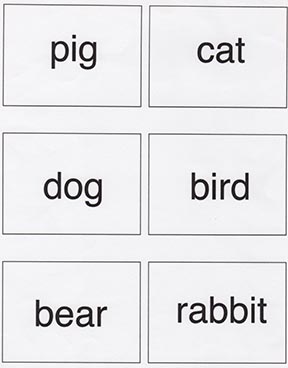LOTTO GAMES: AWESOME NON-VERBAL READING TOOLS
Lotto or matching games are beloved by me and particularly by my non-verbal students. They absolutely love smacking those word cards down on the correct picture–or picture to the word–and sometimes there is more than a hint of relief and even impatience, as if they’re saying, “Why didn’t you ask me to do this earlier? I can read and I can prove it!”
What’s a Lotto Game?
It’s a matching game with typically 6 images to a sheet, with a corresponding sheet of 6 words. For younger readers, you can have 4 images to a sheet, but they will quickly outgrow that material, so I suggest 6 up. In the beginning, you can cover half the sheet to expose just 3 images, or cover one third of the sheet to expose just 4 images if you like.
Who Is It For?
I highly recommend them for two types of students: any-and-all emergent readers, and specifically for non-verbal emergent readers. It’s an elegant first step in best practice, and the students love proving they can read.
Where Can I Get Them?
I’ve made many for my students; you can make some yourself or you can take the easy way out and simply order them from the Down Syndrome Foundation of Orange County. They offer over 25 of these sets, from food to sports and in between, and they’re not expensive.
Here is the spelled-out url: http://dsfoc.org/article/purchase-resources-dsfs-online-store. I’m giving that to you because I just now checked on their site and that page is asleep at the wheel, with no live links to their product pages. So call them at (949) 757-1177 if their site isn’t repaired by the time you read this. You can also email them at info@dsfoc.org if you need to. You can find other resources online, but I think these materials are absolutely the best for the best price, so give it a try.
In the meantime, here are PDF links to my lotto game shown here. You can get started with this one until you get more: pig pic sheet and pig word sheet.
How Do I Use This?
Here is a summary of the steps, from easy to difficult:
FIRST: “Fast Flash” the word cards (see my “Fast Flash” blog for how to)
1. Have the child match picture to picture
2. Match word to word with prompts if needed
3. Match word to picture with prompts
4. Match word to picture, no prompts
5. Match picture to word with prompts
6. Match picture to word, no prompts
LAST: “Fast Flash” the word cards (see my “Fast Flash” blog for “how to”)
FAQs:
Q. Can I put the words in the same position on their page as the pictures are on the pic sheet?
A. Not on your life. Our kids are brilliant at memorizing positions on a page. So when you get to #6, “Match picture to word,” they know exactly where to put that picture. Are they reading the word underneath? No. They simply remember where the picture belongs. Aha! So don’t do that. That was one mistake the DSFOC made in their first printing. Later they realized the problem and switched right column with left column. That’s better, but best of all is to scramble the words/images as I have in the Pig Lotto pictures here. We want to trip up those little position memorizers! We want them to read.
Q. Does size matter for images and words?
A. You bet. Go as large as possible with both within the space you’ve got to work with, 1/6 of a page. Learning will go faster because the brain registers it more easily.
Q. Why do you have them do #1, matching pictures to pictures? That’s too easy.
A. Right. They could do that in their sleep. But I have two good reasons for putting it at the starting gate. One, it’s so easy that they get the idea, “Hey, I can do this! This is a snap!” In other words, it builds their confidence. Confidence is key in reading progress. Two, no two pictures of a monkey, for example, are alike. I want them to know that “this is monkey” so that there’s no confusion when it comes to matching the word “monkey” to the picture “monkey.”
Q. Do we help them out with prompts until they learn the words?
A. Absolutely. Remember that we promote “Errorless Testing” techniques, from matching to selecting to naming, in that order, and at each step of the way, we help out with prompts until they’re independently able to do the steps.
Q. How are they actually going to learn those 6 words?
A. I’m so glad you asked. They will learn them by the Fast Flash method. This is far and away the quickest way to get those words solidly in the brain. So remember to begin and end the lotto game by Fast Flashing the words.
Q. Any other tips?
A. Yes. Laminate both the full sheets and the cards. You’ll be so glad you did (trust me on this.) Create one lotto game made of family members with real pictures; create another of their favorite foods or activities, etc.
Go for it! You will love it, and so will your kids–I promise.




I was was seeing what sized front they used in the Orange County materials. We’ve had success with 72 Pt. font. Just guessing it seems theirs is smaller. I am sure I could put a sticker over it or see if I could edit the file if need be.
I love this blog. I don’t know what I’d do without you and your great info! Thank you so much!
Patty, you are so welcome! I wish you the greatest of success with teaching your child.